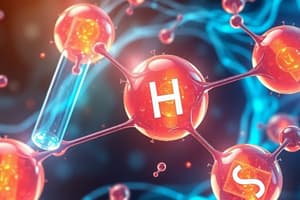Podcast
Questions and Answers
What is hydrogenation and what is the general reaction associated with it?
What is hydrogenation and what is the general reaction associated with it?
Hydrogenation is a chemical reaction that adds hydrogen (H₂) to an alkene, converting it into an alkane. The general reaction is: Alkene + H₂ → Alkane.
List three common catalysts used in the hydrogenation process.
List three common catalysts used in the hydrogenation process.
Nickel (Ni), Platinum (Pt), and Palladium (Pd).
Describe the role of temperature and pressure in hydrogenation.
Describe the role of temperature and pressure in hydrogenation.
Moderate temperatures (25-150 °C) and often increased pressure are used to enhance the reaction rate during hydrogenation.
Explain the mechanism of hydrogenation in terms of key steps.
Explain the mechanism of hydrogenation in terms of key steps.
What is syn addition in the context of hydrogenation and why is it significant?
What is syn addition in the context of hydrogenation and why is it significant?
Discuss the application of hydrogenation in the food industry.
Discuss the application of hydrogenation in the food industry.
What is selective hydrogenation and how does it differ from complete hydrogenation?
What is selective hydrogenation and how does it differ from complete hydrogenation?
What are some environmental considerations associated with hydrogenation processes?
What are some environmental considerations associated with hydrogenation processes?
Study Notes
Alkenes: Hydrogenation Processes
-
Definition of Hydrogenation:
- Hydrogenation is a chemical reaction that involves the addition of hydrogen (H₂) to an alkene, converting it into an alkane.
-
General Reaction:
- Alkene + H₂ → Alkane
- Example: Ethene (C₂H₄) + H₂ → Ethane (C₂H₆)
-
Catalysts Used in Hydrogenation:
- Typically requires a catalyst to proceed at a reasonable rate.
- Common catalysts include:
- Nickel (Ni)
- Platinum (Pt)
- Palladium (Pd)
- Catalysts can be used in different forms (supported or unsupported).
-
Reaction Conditions:
- Temperature: Generally moderate (25-150 °C).
- Pressure: Often increased pressure is used to enhance reaction rate.
-
Mechanism Overview:
- Adsorption: Alkene and hydrogen adsorb onto the surface of the catalyst.
- Formation of a π-complex: Alkene double bond interacts with the catalyst.
- Hydrogen Addition: Hydrogen atoms are added to the carbon atoms of the double bond.
- Desorption: The newly formed alkane is released from the catalyst surface.
-
Stereochemistry:
- Hydrogenation can lead to stereochemical outcomes, including:
- Syn addition: Both hydrogen atoms add to the same side of the double bond.
- Stereospecificity is particularly relevant for cyclic alkenes.
- Hydrogenation can lead to stereochemical outcomes, including:
-
Applications of Hydrogenation:
- Production of saturated hydrocarbons from unsaturated feedstocks.
- Used in the food industry (e.g., hydrogenating vegetable oils to create margarine).
- Important in pharmaceuticals and petrochemical industries for modifying compounds.
-
Selective Hydrogenation:
- Can be used to selectively hydrogenate specific functional groups in complex molecules.
- Controlled conditions can allow for partial hydrogenation, preserving double bonds in some areas.
-
Environmental Considerations:
- The process can have implications in reducing unsaturated compounds that may contribute to pollution.
- Efficient catalysts can minimize waste and reduce energy consumption.
Hydrogenation of Alkenes
- Hydrogenation involves adding hydrogen (H₂) to an alkene, transforming it into an alkane.
- General reaction: Alkene + H₂ → Alkane; example: Ethene (C₂H₄) is converted to Ethane (C₂H₆).
Catalysts in Hydrogenation
- Hydrogenation typically requires a catalyst for effective reaction rates.
- Common catalysts include Nickel (Ni), Platinum (Pt), and Palladium (Pd).
- Catalysts may be used in supported (on another material) or unsupported forms.
Reaction Conditions
- Moderate temperatures (25-150 °C) are generally optimal for hydrogenation.
- Increased pressure is often applied to accelerate the reaction.
Mechanism of Hydrogenation
- Adsorption: Both alkene and hydrogen adhere to the catalyst's surface.
- Formation of π-complex: The alkene's double bond interacts with the catalyst.
- Hydrogen Addition: Hydrogen atoms bond to the alkene's carbon atoms at the double bond.
- Desorption: The resulting alkane is released from the catalyst surface.
Stereochemistry
- Hydrogenation can result in stereochemical outcomes such as syn addition, where both hydrogen atoms add to the same side of the double bond.
- Stereospecificity is significant for cyclic alkenes, affecting their geometric configurations.
Applications of Hydrogenation
- Transforms unsaturated feedstocks into saturated hydrocarbons, widely used in industrial processes.
- Common in the food industry for hydrogenating vegetable oils to produce margarine.
- Utilized in pharmaceuticals and petrochemicals to modify chemical compounds.
Selective Hydrogenation
- Enables the selective hydrogenation of specific functional groups within complex molecules.
- Controlled conditions facilitate partial hydrogenation, leaving some double bonds unaltered.
Environmental Impact
- Hydrogenation can mitigate pollution by reducing unsaturated compounds.
- Utilizing efficient catalysts aids in waste reduction and decreases energy consumption during reactions.
Studying That Suits You
Use AI to generate personalized quizzes and flashcards to suit your learning preferences.
Description
This quiz explores the hydrogenation processes of alkenes, including the definition, general reactions, and catalysts used in the reaction. It covers important reaction conditions and the mechanism involved in the hydrogen addition to alkenes.




